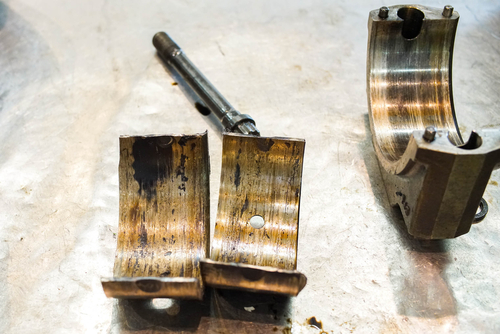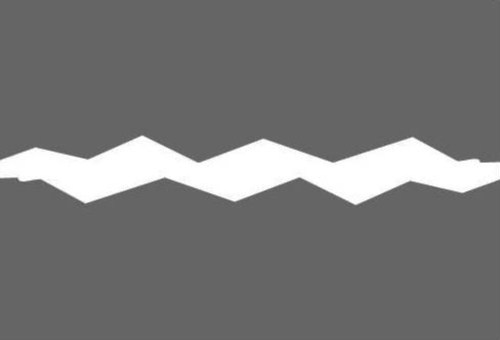
We all know that lack of lubrication usually causes engine bearings to fail, but we have all seen bearing failures where the causes were not clear or immediately apparent. The oil level may have been up to the proper mark, the oil pressure may not have fallen below acceptable levels, the oil may not have been degraded, or there may not have been excessive levels of contaminants or wear particles in the oil, and yet the bearings failed. If you have ever wondered how it is possible for engine bearings to fail for no apparent reason, this article will answer all the questions you have ever wanted to ask about bearing failures, starting with this question-
In simple terms, bearing lubrication is characterised by the presence of a thin film of pressurised oil between the journal and bearing surfaces but contrary to popular belief, this film of oil, also known as a “squeeze film”, is not established by the oil pressure alone. While a specified minimum oil pressure is required to deliver sufficient quantities of oil to all bearing journals, the actual squeeze film is in fact established and maintained by the rotation of the journal within the bearing.
As a practical matter though, bearing lubrication can occur in any one of three states, each of which is defined by the ratio between the thickness of the squeeze film (expressed as “h”), and the surface roughness (expressed as “Ra”) of both the bearing and journal surfaces. In engineering jargon, each state of lubrication is referred to as a “lubrication regime” and a graphic representation of each is shown below. Note that the white spaces between the surfaces represent a film of lubricant, and that details of the surface roughness in each representation are greatly exaggerated for clarity-
Boundary lubrication

During boundary lubrication conditions there is constant contact between micro asperities (microscopic high spots on surfaces) on both the journal and bearing surfaces, which makes this the least desirable lubrication regime, although it cannot be avoided altogether, since it occurs during engine start-ups/shutdowns, as well as during high engine loads at low engine speeds.
Although EP (extreme pressure) oil additives are designed to mitigate the effects of boundary lubrication conditions, this regime is characterised by extremely high friction coefficients, increased mechanical wear as opposing micro asperities grind each other down through metal-to-metal contact, and non-uniform bearing loads and temperatures. These factors can combine to produce severe bearing failures even though engine oil is available in sufficient quantities and at specified pressures.
Mixed lubrication

Mixed lubrication can be described as an intermediate lubrication regime that occurs roughly at the mid-point between the boundary and hydrodynamic lubrication regimes. Under these conditions there is intermittent contact between micro asperities, with the level of metal-to-metal contact depending on engine speed/load, as well as on factors such as oil viscosity, oil pressure, and the degree of wear present on both the bearing and journal surfaces.
However, the mixed lubrication regime is inherently unstable since the cyclical loads imparted to bearings by the combustion cycle causes intermittent metal-to-metal contact, which in turn, causes cyclical increases in the friction coefficient, thereby causing cyclical oil temperature increases, which ultimately, produces reductions in oil viscosity and hence, increased bearing wear rates.
Hydrodynamic lubrication

In the hydrodynamic lubrication regime, there is no direct contact between micro asperities since the rotation of the bearing journal drags the squeeze film of lubricating oil around itself, which has the effect of keeping the journal and bearing surfaces apart.
Although hydrodynamic lubrication is inherently stable, the thickness of the squeeze film is not uniform around the entire circumference of the journal during each rotation of the journal. In practice, if no loads are applied to a bearing that is operating in the hydrodynamic lubrication regime, the journal will rotate in the geometric centre of the bearing. However, when a load such as combustion pressure is applied to the bearing via the connecting rod, the journal moves out of the concentric position, which creates what is known as a “converging gap” between the journal and bearing surfaces.
In engineering parlance, the converging gap is the area where the squeeze film of oil is the thinnest, and although the converging gap moves around the journal in the direction of rotation, no direct metal-to-metal contact occurs at any point during a journal’s rotation. In practice, direct metal-to-metal contact is prevented by the oil pressure and the strength of the hydrodynamic forces (that maintain the squeeze film) that combine to counteract the external load, which in this case, is the combustion pressure. Note that the position of the journal within the bearing at any point during a rotation is always at the point where the oil pressure, the hydrodynamic forces, and external loads are in equilibrium.
Note though that since the journal moves around within the bearing, this movement sets up a very powerful pumping action as a part of the squeeze film is displaced by the journal’s movement during each rotation. While the pumping action itself is not harmful, the pressure fluctuations that accompany the pumping action can be harmful, since they create two forms of cavitation in the low-pressure side of the squeeze film, the first being-
Gaseous cavitation
Since the squeeze film of oil is divided into high -, and low pressure areas by the converging gap, dissolved gases like atmospheric air and others tend to escape from the oil in the low pressure side when the atmospheric pressure is lower than the pressure in the squeeze film. The escaping gases form gas-filled cavities in the oil, which are carried around the journal to the high-pressure area in the squeeze film. When the gas-filled cavities are subjected to higher pressures, the gases are reabsorbed into the oil but in practice, this form of cavitation is harmless and does not significantly contribute to bearing wear or degradation of the oil.
Vapour cavitation
During high engine speeds, the cyclic loads on bearings fluctuate rapidly, which causes the pressure in the low-pressure side of the squeeze film to dissipate almost instantly, with the practical effect of this being that the rapid loss of pressure causes a form of cavitation that is roughly analogous to the way cavities form in boiling liquids. When the cavities in the oil are transported to the high-pressure side of the converging gap by the journal’s rotation, the cavities collapse almost as fast as they formed, which results in a type of impact pressure that strips metal from the bearing surface, albeit only a few molecules at a time.
Over extended periods, this erosion of the bearing surface can eventually remove large parts of the bearing surface, which necessarily results in increasing the journal/bearing clearance, which in turn causes a progressive loss of the supporting force supplied by the oil pressure. In practice, this means that depending on the degree of erosion of the bearing surface, the lubrication regime in one or more bearings can change from hydrodynamic where there is no metal-to-metal contact, to the mixed regime where intermittent metal-to-metal contact occurs, to boundary lubrication conditions where metal-to-metal contact is permanent, which brings us to-
From the above it should be obvious that the ideal lubrication regime is hydrodynamic lubrication and in a perfect engine, the bearings would last virtually forever if this lubrication regime could be maintained. However, no engine is perfect and engine oil has a finite useful life, and if these two factors are added to some others listed below, it is a miracle that engine bearings last for as long as they do. Below are some of the most important factors that can cause lubrication regimes to change from ideal to extremely undesirable-
Oil starvation
While low oil levels can obviously cause bearings to suffer oil starvation, operating the engine at high loads and low engine speeds is just as harmful as low oil levels. Since the oil pressure is dependent on the engine speed, a low engine speed cannot always deliver sufficient oil pressure to maintain a stable squeeze film.
Low oil viscosity and elevated temperatures
Since the stability of the squeeze film depends on the shear strength of the oil as a function of its viscosity, oil dilution, and/or increased viscosity of the oil as the result of elevated temperatures can cause the squeeze film to collapse under some operating conditions. As a practical matter, hydrodynamic lubrication depends on the journal dragging a film of oil around itself; therefore, increased oil velocity can cause the squeeze film to collapse especially at the converging gap where the clearance between the journal and the bearing surface is the smallest, which could create mixed lubrication conditions, albeit intermittently.
Geometrical distortions and/or misalignments
Although modern manufacturing and/or rebuilding methods now produce crankshaft journals and connecting rod big ends that are almost circular and parallel, the increasing use of synthetic engine oil* has resulted in operating clearances that are becoming progressively smaller as engines evolve.
*Since synthetic oil is distilled from various gases, the molecules in the resulting base oil are all the same size, which makes smaller operating clearances possible because the friction load is shared equally by all the oil molecules.
If we add the reality of decreasing operating clearances to the fact that crankshafts still flex measurably under high loads, (hence the need for harmonic balancers) despite the enormous structural strength of modern engine blocks. Therefore, it should be obvious that even minute misalignments and/or distortions of bearing caps of both main and big end bearings can have serious negative effects on bearing life.
In addition, minute imbalances on crankshafts and/or connecting rods can produce lateral and torsional accelerations and deflections in parts of a crankshaft that can sometimes overcome the oil squeeze films’ ability to maintain sufficient operating clearances between some journals and bearing surfaces.
Depending on the degree of misalignment and/or distortion, the hydrodynamic lubrication regime can therefore change to the mixed or even the boundary regime under certain operating conditions, or worse, different lubrication regimes may be present on some parts of one or more bearings/journals at the same time. If this happens, bearing wear is not only uneven but the uneven wear can disrupt or even prevent a stable squeeze film from being established further increasing bearing wear, which brings us to the-
In an ideal world, we would only ever work with engine bearings that possess all the properties and characteristics that prevent premature bearing failure. Thus, in an ideal world, and provided that the engine oil is not excessively degraded or overly contaminated, all engine bearings would provide stable and reliable operation in both the mixed and hydrodynamic lubrication regimes under all operating conditions.
However, we do not live in an ideal world, engines are not perfect, and engine bearings are not created equal, so when we do replace engine bearings we expect them to provide stable and reliable long-term service, which can only happen when the replacement bearings have the following properties-
High resistance to cavitation
Since the formation of cavitation bubbles is impossible to avoid at high engine speeds, and especially when the bearings are operating in the hydrodynamic lubrication regime when localised but acute pressure drops occur in the squeeze film, this is perhaps the most important quality any engine bearing should have.
High fatigue strength
As fatigue strength pertains to engine bearings, the term is defined as the maximum number of cyclic loads the bearing can withstand without failing. Thus, if after an infinite number of cyclic loads and inertial forces the bearing develops fatigue cracks, these cracks will spread to the steel backing layer, which will cause the bearing material to flake off the backing layer.
High seizure resistance
This is defined as the bearing’s ability to resist bonding with the journal surface when the bearing operates in the mixed lubrication regime, which is when intermittent metal-to-metal contact occurs.
High wear resistance
This refers to a bearing’s ability to resist changes to any of its dimensions in the mixed lubrication regime when wear particles and solid contaminants are trapped between the bearing and journal surfaces.
High conformability
Put simply, a bearing should have the ability to conform to small irregularities, deformations, or mechanical misalignments of its housing and/or journal. Poor conformability could cause localised “high spots” with a resulting localised decrease in the thickness of the squeeze film. If the localised high spot decreases the bearing/journal clearance to zero, high specific loads will almost certainly cause boundary lubrication conditions in that spot, thus causing excessive localised wear and possibly, localised seizure of the bearing.
High embedability
This refers to a bearing’s ability to entrap small solid contaminants, and to force such entrapped solid contaminates into itself but to below the level of its surface. Poor embedability causes solid contaminants to remain on the bearing’s surface, which causes accelerated wear of both the bearing and journal’s surfaces, thus increasing the possibility of bearing seizure.
High corrosion resistance
All high quality engine bearings should have the ability to continually resist chemical attack by the acids that from in oil during normal engine operation.
From the above it should be obvious that defects in engine bearings themselves can cause engine failures as easily as a demonstrable lack of lubrication can. However, since defects in replacement bearings are often not detectable or readily apparent, the only way to avoid a “mysterious” bearing failure is to use replacement engine bearings from reputable and trusted suppliers, who spend large amounts of money to ensure that their products are as perfect as they can be.